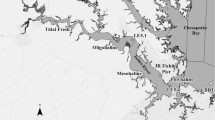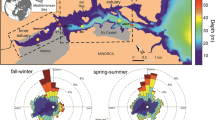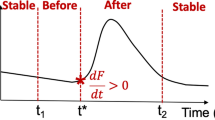Abstract
We examined the short-term (<1 month post-storm) impact of storms [Tropical Storm (TS) Helene in 2000, Hurricane (H) Isabel in 2003, H Alex, Tropical Depression (TD) Bonnie and TS Charley in 2004] varying in their trajectory, wind and rainfall characteristics, on water column structure, nutrients, and phytoplankton biomass in North Carolina’s Neuse R. Estuary (NRE). Data are presented from two sampling programs, ModMon (biweekly) and FerryMon (measurements made every 3 min daily). Helene’s winds mixed the previously stratified water column, delivering sediment-bound nutrients to the euphotic zone, and localized freshwater input from Helene was also evident. Mean chlorophyll a concentrations in the mesohaline portion of the NRE, where N was strongly limiting before the storm (molar DIN:DIP < 1), more than doubled after the storm. Unlike with Helene, the water column was well mixed before passage of Isabel, and nutrient concentrations were high. As a result, minimal impact on phytoplankton biomass was detected despite Isabel’s high winds and significant freshwater input. In fact, conditions became less favorable for phytoplankton growth after the storm. Alex was fast moving and relatively small, but its winds were sufficient to mix the water column. Although data from ModMon suggest that chlorophyll a was only slightly higher after passage of Alex, FerryMon detected an ephemeral bloom that was missed by ModMon. Overall, these results suggest that relatively small tropical storms and hurricanes can lead to significant increases in phytoplankton biomass. However, the phytoplankton response depends on both the characteristics of a particular storm and the physical–chemical conditions of the water column before storm passage. Finally, the ephemeral bloom that developed as a result of Alex, the strong response of phytoplankton in the mesohaline portion of the estuary to nutrient inputs, and their patchiness on several other occasions suggests that storms may create “hot spots” for trophic transfer and biogeochemical dynamics in estuaries. Adaptive sampling is necessary to capture these features and to fully understand the impact of perturbations such as storms on estuarine ecosystem functioning.









Similar content being viewed by others
References
Bales, J.D. 2003. Effects of Hurricane Floyd inland flooding, September–October 1999, on tributaries to Pamlico Sound, North Carolina. Estuaries 26: 1319–1328.
Boyer, J., R.R. Christian, and D.W. Stanley. 1993. Patterns of phytoplankton primary productivity in the Neuse River Estuary, North Carolina. Marine Ecology Progress Series 97: 287–297.
Buzzelli, C.P., R.A. Luettich, S.P. Powers, C.H. Peterson, J.E. McNinch, J.L. Pinckney, and H.W. Paerl. 2002. Estimating the spatial extent of bottom-water hypoxia and habitat degradation in a shallow estuary. Marine Ecology Progress Series 230: 103–112.
Buzzelli, C.P., J.R. Ramus, and H.W. Paerl. 2003. Ferry-based monitoring of surface water quality in North Carolina estuaries. Estuaries 26: 975–984.
Christian, R.R., J.N. Boyer, and D.W. Stanley. 1991. Multi-year distribution patterns of nutrients within the Neuse River estuary, North Carolina. Marine Ecology Progress Series 71: 259–274.
Conley, D.J. 1999. Biogeochemical nutrient cycles and nutrient management strategies. Hydrobiologia 410: 87–96.
Emanuel, K. 2005. Increasing destructiveness of tropical cyclones over the past 30 years. Nature 436: 686–688.
Franks, P.J.S. 1992. Phytoplankton blooms at fronts—patterns, scales and physical forcing mechanisms. Reviews in Aquatic Sciences 6: 121–137.
Gallegos, C.L., and T.E. Jordan. 1997. Seasonal progression of factors limiting phytoplankton pigment biomass in the Rhode River estuary, Maryland (USA). I. Controls on phytoplankton growth. Marine Ecology Progress Series 161: 185–198.
Gallegos, C.L., T.E. Jordan, and D.L. Correll. 1992. Event-scale response of phytoplankton to watershed inputs in a subestuary—timing, magnitude, and location of blooms. Limnology and Oceanography 37: 813–828.
Goldenberg, S.B., C.W. Landsea, A.M. Mestas-Nuzes, and W.M. Gray. 2001. The recent increase in Atlantic Hurricane activity: causes and implications. Science 293: 474–479.
Hagy, J.D., J.C. Lehrter, and M.C. Murrell. 2006. Effects of Hurricane Ivan on water quality in Pensacola Bay, Florida. Estuaries and Coasts 29: 919–925.
Harding, L.W. 1994. Long-term trends in the distribution of phytoplankton in Chesapeake Bay- roles of light, nutrients and streamflow. Marine Ecology Progress Series 104: 267–291.
Hobbie, J.E. 2000. Estuarine science: a synthetic approach to research and practice. Washington (D.C.): Island Press.
Incze, L.S., and C.M. Yentsch. 1981. Stable density fronts and dinoflagellate patches in a tidal estuary. Estuarine, Coastal and Shelf Science 13: 547–556.
Joint, I.R., and A.J. Pomeroy. 1981. Primary production in a turbid estuary. Estuarine, Coastal and Shelf Science 13: 303–316.
Lewitus, A.J., D.L. White, R.G. Tymowski, M.E. Geesey, S.N. Hymel, and P.A. Noble. 2005. Adapting the CHEMTAX method for assessing phytoplankton taxonomic composition in southeastern U.S. estuaries. Estuaries 28: 160–172.
Luettich, R.A., J.E. McNinch, H.W. Paerl, C.P. Peterson, J.T. Wells, M. Alperin, C.S. Martens, and J.L. Pinckney. 2000. Neuse River Estuary modeling and monitoring project stage 1: hydrography and circulation, water column nutrients and productivity, sedimentary processes and benthic-pelagic coupling. Report UNC-WRRI-2000–325B, Water Resources Research Institute of the University of North Carolina, Raleigh, NC, 172pp.
Mackey, M.D., D.J. Mackey, H.W. Higgins, and S.W. Wright. 1996. CHEMTAX—A program for estimating class abundances from chemical markers: application to HPLC measurements of phytoplankton. Marine Ecology Progress Series 144: 265–283.
Mallin, M.A., and C.A. Corbett. 2006. How hurricane attributes determine the extent of environmental effects: Multiple hurricanes and different coastal systems. Estuaries and Coasts 29: 1046–1061.
Malone, T.C., D.J. Conley, T.R. Fisher, P.M. Glibert, L.W. Harding, and K.G. Sellner. 1996. Scales of nutrient-limited phytoplankton productivity in Chesapeake Bay. Estuaries 192B: 371–385.
Malone, T.C., L.H. Crocker, S.E. Pike, and B.W. Wendler. 1988. Influences of river flow on the dynamics of phytoplankton production in a partially stratified estuary. Marine Ecology Progress Series 48: 235–249.
Miller, W.D., L.W. Harding, and J.E. Adolf. 2006. Hurricane Isabel generated an unusual fall bloom in Chesapeake Bay. Geophysical Research Letters 33: L06612. DOI 10.1029/2005GL025658.
Mortazavi, B., R.L. Iverson, W.M. Landing, F.G. Lewis, and W.R. Huang. 2000. Control of phytoplankton production and biomass in a river-dominated estuary: Apalachicola Bay, Florida, USA. Marine Ecology Progress Series 198: 19–31.
Paerl, H.W., J.L. Pinckney, J.M. Fear, and B.J. Peierls. 1998. Ecosystem responses to internal and watershed organic matter loading: consequences for hypoxia in the eutrophying Neuse River Estuary, North Carolina, USA. Marine Ecology Progress Series 166: 17–25.
Paerl, H.W., J.D. Bales, L.W. Ausley, C.P. Buzzelli, L.B. Crowder, L.A. Eby, J.M. Fear, M. Go, B.L. Peierls, T.L. Richardson, and J.S. Ramus. 2001. Ecosystem impacts of three sequential hurricanes (Dennis, Floyd, and Irene) on the United States’ largest lagoonal estuary, Pamlico Sound, NC. Proceedings of the National Academy of Sciences 98: 5655–5660.
Paerl, H.W., L.M. Valdes, J.E. Adolf, B.M. Peierls, and L.J. Harding. 2006a. Anthropogenic and climatic influences on the eutrophication of large estuarine ecosystems. Limnology and Oceanography 51: 448–462.
Paerl, H.W., L.M. Valdes, A.R. Joyner, B.L. Peierls, M.F. Piehler, S.R. Riggs, R.R. Christian, L.A. Eby, L.B. Crowder, J.S. Ramus, E.J. Clesceri, C.P. Buzzelli, and R.J. Luettich. 2006b. Ecological response to hurricane events in the Pamlico Sound System, North Carolina and implications for assessment and management in a regime of increased frequency. Estuaries and Coasts 296A: 1033–1045.
Peierls, B.L., R.R. Christian, and H.W. Paerl. 2003. Water quality and phytoplankton as indicators of hurricane impacts on a large estuarine ecosystem. Estuaries 26: 1329–1343.
Pinckney, J.L., B.F. Millie, B.T. Vinyard, and H.W. Paerl. 1997. Environmental controls of phytoplankton bloom dynamics in the Neuse River Estuary, North Carolina, USA. Canadian Journal of Fisheries and Aquatic Sciences 54: 2491–2501.
Pinckney, J.L., H.W. Paerl, and M.B. Harrington. 1999. Responses of the phytoplankton community growth rate to nutrient pulses in variable estuarine environments. Journal of Phycology 35: 1455–1463.
Reynolds-Fleming, J.V., and R.A. Luettich. 2004. Wind-driven lateral variability in a partially mixed estuary. Estuarine, Coastal and Shelf Science 60: 395–407.
Rizzo, W.M., G.J. Lackey, and R.R. Christian. 1992. Significance of euphotic, subtidal sediments to oxygen and nutrient cycling in a temperate estuary. Marine Ecology Progress Series 86: 51–61.
Rudek, J., H.W. Paerl, M.A. Mallin, and P.W. Bates. 1991. Seasonal and hydrological control of phytoplankton nutrient limitation in the lower Neuse River Estuary, North Carolina. Marine Ecology Progress Series 75: 133–142.
Stow, C.A., C. Roessler, M.E. Borsuk, J.D. Bowen, and K.H. Reckhow. 2003. Comparison of estuarine water quality models for total maximum daily load development in Neuse River Estuary. Journal of Water Resources Planning and Management 129: 307–314.
Tester, P.A., S.M. Varnam, S.E. Culver, D.L. Eslinger, R.P. Stumpf, R.N. Swift, J.K. Yungel, M.D. Black, and R.W. Litaker. 2003. Airborne detection of ecosystem responses to an extreme event: Phytoplankton displacement and abundance after hurricane induced flooding in the Pamlico-Albemarle Sound system, North Carolina. Estuaries 26: 1353–1364.
Twomey, L.J., M.F. Piehler, and H.W. Paerl. 2005. Phytoplankton uptake of ammonium, nitrate and urea in the Neuse River Estuary, NC, USA. Hydrobiologia 533: 123–134.
Webster, P.J., G.J. Holland, J.A. Curry, and H.R. Chang. 2005. Changes in tropical cyclone number, duration, and intensity in a warming environment. Science 309: 1844–1846.
Valdes-Weaver, L.M., M.F. Piehler, J.L. Pinckney, K.E. Howe, K. Rossignol, and H.W. Paerl. 2006. Long-term temporal and spatial trends in phytoplankton biomass and class-level taxonomic composition in the hydrologically variable Neuse–Pamlico estuarine continuum, North Carolina, U.S.A. Limnology and Oceanography 51: 1410–1420.
Acknowledgements
We thank the many technicians and students who have participated in the ModMon and FerryMon programs over the years. We also thank two anonymous reviewers whose constructive comments helped to greatly improve this manuscript. ModMon and FerryMon are supported by the North Carolina Dept. of Natural Resources and Community Development, the US EPA STAR Program, the North Carolina Sea Grant Program, and the National Science Foundation Ecosystems, Environmental Geochemistry and Biology, and Ecology of Infectious Diseases programs. MSW was supported by a National Research Council Postdoctoral Fellowship.
Author information
Authors and Affiliations
Corresponding author
Rights and permissions
About this article
Cite this article
Wetz, M.S., Paerl, H.W. Estuarine Phytoplankton Responses to Hurricanes and Tropical Storms with Different Characteristics (Trajectory, Rainfall, Winds). Estuaries and Coasts: J CERF 31, 419–429 (2008). https://doi.org/10.1007/s12237-008-9034-y
Received:
Revised:
Accepted:
Published:
Issue Date:
DOI: https://doi.org/10.1007/s12237-008-9034-y




